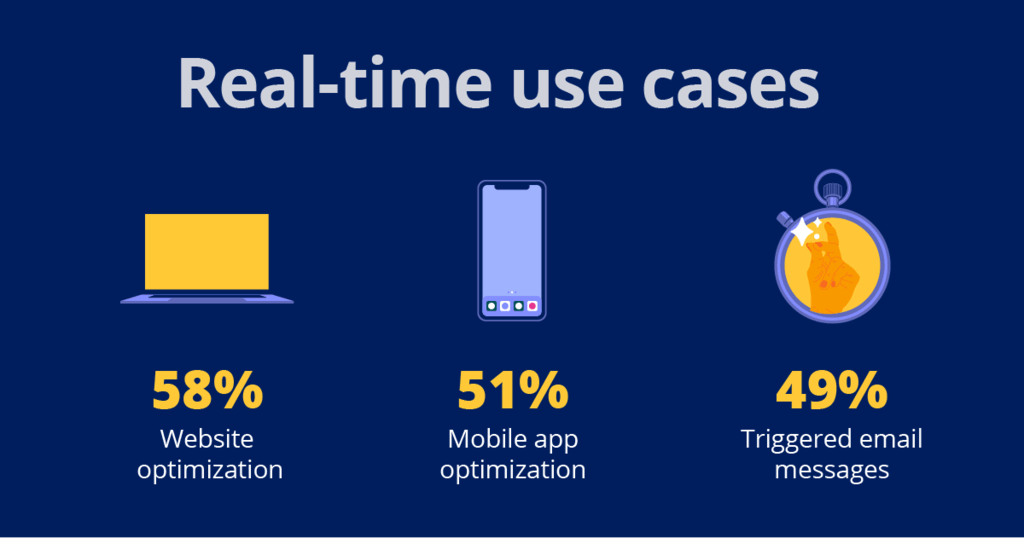Customer experience (CX) had already been established as a key differentiator for organizations trying to outsmart, outsell, and out serve the competition – then COVID-19 hit. Suddenly, digital transformation went from an ongoing initiative to an overnight priority. In the blink of an eye, digital channels became more important than ever and speed became critical. Businesses needed to deliver consistently relevant and empathetic experiences at scale as they happen. This is the foundation of what we call real time.
But what is “real time” exactly? We break it all down in this webinar. Mainly, it’s a term that gets thrown around and attached to a lot of different actions, such as decisioning and analytics. There’s no clear market definition that all vendors work from, despite its importance. To understand how it is being defined in the market and who is investing in this crucial technology, Pega conducted a global survey of over 3,500 participants in 11 countries and across six key industries. To help provide a clearer picture of what real time is and how it can impact a business, we broke down the findings into five key insights every marketing, analytics, and customer experience professional should know.
Insight #1: The definition of real time varies widely
How do you invest in technology when you’re not exactly sure what it is? We know real time is supposed to be fast, but how fast? To help provide a more concrete definition and to align with Pega’s expertise in the area, let’s focus on one of, if not the, top application of real time: real-time decisioning.
When we asked respondents to define real time, we found that of all the organizations claiming real-time capabilities, only 18% were actually doing it (by our definition). The other 82% had much lower standards. As an example, one of the write-in responses was “Real-time is when you’re making decisions very quickly, anywhere from 20 - 60 minutes.”

There’s a big difference between less than a second and up to 60 minutes. This discrepancy can have major impacts on customer experience – you can either be a hero to your customers, serving them in their exact moment of need, or completely letting them down with a delayed or irrelevant action.
Insight #2: Investment in real-time decisioning is low, despite its importance
Technology investments remain a top CX priority for businesses. However, the study found organizations were sticking with technology they know versus investing in newer tech to future-proof their businesses. This is evident when the results of the study showed the top investment (46%) was data management platforms (DMP).
On one hand, we know that people tend to invest in tech they are familiar with and on the other, that can also mean investing in soon-to-be-outdated software. DMPs, for example, rely on cookie-based technology that is quickly being phased out by Google. Their integration capabilities also lag behind, making it difficult to support critical CX components like real-time decisioning and ad platforms like Facebook, Google, Instagram, or YouTube, and so on.

Real-time decisioning, real results
Learn the definition of real time, where early adopters are investing resources, and how to maximize its value.
Customer data platforms (CDP) were the second highest technology investment, with 43% of organizations investing in them. While anyone interested in real time would like to see a higher percentage here, this was still good news for the market. CDPs are a key enabler and data provider for real-time decisioning. Rather than use third-party cookies like a DMP, CDPs have valuable first-party data capabilities, adding much needed context to customer data. This helps businesses gather and make sense of what seems like an endless amount of data and gain some real, actionable insights that can work in concert with real-time technologies. If data is the fuel for a real-time engine, the CDP is the refinery.
Only 39% of companies surveyed are investing in any real-time decisioning capabilities – even though the vast majority (88%) believe they’re even more vital to providing a great customer experience. Part of the lack of investment can be attributed to the lack of understanding around what real time really is. Rather than invest in tech they don’t fully understand, companies often stay too long with technologies and solutions that have previously demonstrated results. However, this is more of a short-term play and likely won’t support their goals in the long run. While it’s clear that organizations see the potential of real time, they still aren’t sure how to invest in it.
The second reason for these results could be that real-time techniques often run counter to the approaches adopted by popular cloud products. Vendors sometimes offer real-time add-ons into their solutions, but it’s not the same as actually integrating with a real-time decision engine and can prove challenging, since batch-drive campaigns and segmentation – what this tech is built for – are the direct opposite of real time.
Insight #3: Behavioral data is the top data source for real time
There are so many types of data you can use to deliver the next best action to each individual customer. Beyond just the types of data available, there are seemingly infinite ways to compile and apply it. To get to the bottom of what truly fuels today’s real-time decisioning initiatives, we asked respondents what data sources were most important; the results were the following:

- Behavioral data: This powerful data source claiming the top spot makes perfect sense. Behavioral data reflects people’s actions and is very predictive. This helps organizations not just deliver what customers need in the moment but anticipate needs – you don’t get more real time than that. Behavioral data helps you keep things relevant and compelling. Some good examples are purchase transactions, web browsing events, mobile conversions, email click-throughs, accepted or declined offers, and so on.
- Cross-channel interaction history: This is, in the simplest terms, behavioral data that’s rolled up and aggregated across time and different channels. Cross-channel interaction history is used to identify patterns in the customer’s behavior over time, and those patterns are used to calculate their propensity to take different actions. Individual behaviors are great, but interaction history lets you evaluate them in the context of the larger relationship.
- Emotional context: Knowing how your customer feels is vital to delivering not just relevant actions but empathetic ones as well. We can all use a bit more empathy these days, right? Emotional context data can include things like customer churn scores, call dispositions, or likelihood to call scores, all of which can be used as clues into customer sentiment. Is your customer in a place to be sold to? Do they need service? Or do they need to be left alone for a little while? Emotional context helps you change course when you need to deliver what’s right for the customer, every time.
Insight #4: Inbound channels are the best place to get started
Another challenge around widespread adoption of real-time decisioning is the lack of understanding around use cases for it. Again, some of it can be attributed to the vague and ever-changing definition, but we can see from early adopters, there are clear places to start in order to see success quickly.
When asked about where organizations were using real-time decisioning, the most common use cases were digital in nature:

- Website optimization (58%): Personalizing ad containers across the site by using high propensity offers and actions.
- Mobile application optimization (51%): Personalizing ad containers and experiences within the app using contextual data.
- Triggered email messages (49%): Dynamically triggering highly relevant messages to a single individual when their propensity to accept spikes, indicating a specific “need.”
These results align with Pega’s view surrounding real-time use cases. Inbound digital channels provide the best use cases for real-time decisioning. Channels like the web and mobile should be the highest priority when organizations decide to invest in real time. For web and mobile optimization, there’s a clear ROI story. Inbound digital channels are a great source of very rich behavioral data and enable organizations to power real-time programs off them. They’re easier to monetize as well -- boosting your digital conversion rates anywhere from 300-500%.
When we look at email, it can be a bit more of a challenge to see immediate returns, since it’s an outbound channel. Outbound communications have a much lower response rate and generate less high-quality behavioral data than inbound channels do. However, email benefits tremendously from having web and mobile programs already in place to generate trigger data when they go live.
Insight #5: Early adopters are seeing results
Even though we’ve established that adoption of real-time decisioning is nowhere near where we believe it should be, those who have made the leap are gaining the edge on their competitors.
One of the most impressive results from the study was 63% of those surveyed saw increased Net Promoter Scores (NPS). Real time has a direct correlation to NPS, driven by experience. The more relevant the experience, the better the experience, and the happier the customer.
Sixty-one percent saw reduced customer churn. Not only are real-time practitioners increasing customer satisfaction, they’re keeping those customers as well. Real time allows organizations to not just remedy customer problems but get ahead of them. And lastly, early adopters showed 45% increase in share of wallet. That comes from using real time to improve conversion and to detect customer needs – like knowing when they come in market for a product. That kind of insight is half the battle when it comes to selling.
The bottom line is, as long as having a superior customer experience remains a priority, real-time decision investment will continue to grow.
More widespread adoption will hopefully lead to greater understanding of the technology as more organizations embrace it – maybe even a standard definition, as well. We look forward to where real-time decisioning is headed in the future.
Learn more:
- Watch our PegaWorld iNspire session, “How real-time decisioning works in the real world,” and learn how to put the power of real time to work for your business.

